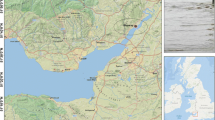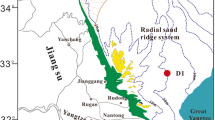Abstract
Estuarine systems are complex environments where seasonal and spatial variations occur in concentrations of suspended particulate matter, in primary constituents, and in organic matter content. This study investigated in the laboratory the flocculation potential of estuarine-suspended particulate matter throughout the year in order to better identify the controlling factors and their hierarchy. Kinetic experiments were performed in the lab with a “video in lab” device, based on a jar test technique, using suspended sediments sampled every 2 months over a 14-month period at three stations in the Seine estuary (France). These sampling stations are representative of (1) the upper estuary, dominated by freshwater, and (2) the middle estuary, characterized by a strong salinity gradient and the presence of an estuarine turbidity maximum. Experiments were performed at a constant low turbulent shear stress characteristic of slack water periods (i.e., a Kolmogorov microscale >1,000 µm). Flocculation processes were estimated using three parameters: flocculation efficiency, flocculation speed, and flocculation time. Results showed that the flocculation that occurred at the three stations was mainly influenced by the concentration of the suspended particulate matter: maximum floc size was observed for concentrations above 0.1 g l−1 while no flocculation was observed for concentrations below 0.004 g l−1. Diatom blooms strongly enhanced flocculation speed and, to a lesser extent, flocculation efficiency. During this period, the maximum flocculation speed of 6 µm min−1 corresponded to a flocculation time of less than 20 min. Salinity did not appear to automatically enhance flocculation, which depended on the constituents of suspended sediments and on the content and concentration of organic matter. Examination of the variability of 2D fractal dimension during flocculation experiments revealed restructuring of flocs during aggregation. This was observed as a rapid decrease in the floc fractal dimension from 2 to 1.4 during the first minutes of the flocculation stage, followed by a slight increase up to 1.8. Deflocculation experiments enabled determination of the influence of turbulent structures on flocculation processes and confirmed that turbulent intensity is one of the main determining factors of maximum floc size.















Similar content being viewed by others
References
Alldredge, A.L., C. Gotschalk, U. Passow, and U. Riebesell. 1995. Mass aggregation of diatom blooms: insights from a mesocosm study. Deep-Sea Research II 42(1): 9–27.
Avoine, J. 1981. Estuaire de la Seine: sédiments et dynamique sédimentaire, Université de Caen: 236p.
Avoine, J. 1986. Evaluation des apports fluviatiles dans l'estuaire de la Seine. Caen, Ifremer: La baie de Seine (GRECO MANCHE).
Berhane, I., R.W. Sternberg, G.C. Kineke, T.G. Milligan, and K. Kranck. 1997. The variability of suspended aggregates on the Amazon Continental Shelf. Continental Shelf Research 17(3): 267–285.
Billiones, R.G., M.L. Tackx, and M.H. Daro. 1999. The geometric features, shape factors and fractal dimensions of suspended particulate matter in the Scheldt Estuary (Belgium). Estuarine, Coastal and Shelf Science 48: 293–305.
Chakraborti, R.K., K.H. Gardner, J.F. Atkinson, and J.E. Van Benschoten. 2003. Changes in fractal dimension during aggregation. Water Research 37(4): 873–883.
Chen, S., and D. Eisma. 1995. Fractal geometry of in-situ flocs in the estuarine and coastal environments. Netherlands Journal of Sea Research 32(2): 173–182.
Dupont, J.-P. 2001. Matériaux fins: le cheminement des particules en suspension. Programme Scientifique Seine Aval, Programme Scientifique Seine Aval: 39p.
Dyer, K.R. 1986. Coastal and estuarine sediment dynamics. Chichester: Wiley.
Edzwald, J.K., J.B. Upchurch, and C.R. O'Melia. 1974. Coagulation in estuaries. Environmental Science and Technology 8: 58–63.
Eisma, D. 1993. Suspended matter in the aquatic environment. New York: Springer.
Eisma, D., J. D. Boon, R. Groenewegen, V. Ittekkot, J. Kalf and W. G. Mook. 1983. Observations on macro-aggregates, particle size and organic composition of suspended mater in the Ems Estuary. Mitt. Geol. Paläont. Inst. Univ. Hamburg 55: 295–314.
Eisma, D., P. Bernard, G.C. Cadée, V. Ittekkot, J. Kalf, R. Laane, J.M. Martin, W.G. Mook, A. van Put, and T. Schumacher. 1991a. Suspended matter particle size in some west European estuaries; Part I: particle size distribution. Netherlands Journal of Sea Research 28(3): 193–214.
Eisma, D., P. Bernard, G.C. Cadée, V. Ittekkot, J. Kalf, R. Laane, J.M. Martin, W.G. Mook, A. van Put, and T. Schumacher. 1991b. Suspended-matter particle size in some west-european estuaries; Part II: a review on floc formation and break-up. Netherlands Journal of Sea Research 28(3): 215–220.
Eisma, D., A.J. Bale, M.P. Dearnaley, M.J. Fennessy, W. van Leussen, M.-A. Maldiney, A. Pfeiffer, and J.T. Wells. 1996. Intercomparison of in-situ suspended matter (floc) size measurement. Journal of Sea Research 36(1/2): 3–14.
Etcheber, H., A. Taillez, G. Abril, J. Garnier, P. Servais, F. Moatar, and M.V. Commarieu. 2007. Particulate organic carbon in the Estuarine Turbidity Maxima of the Gironde, Loire and Seine Estuaries: origin and lability. Hydrobiologia 588: 245–259.
Fennessy, M.J., K.R. Dyer, and D.A. Huntley. 1994. INSSEV: an instrument to measure the size and settling velocity of flocs in situ. Marine geology 117: 107–117.
Flory, E.N., P.S. Hill, T.G. Milligan, and J. Grant. 2004. The relationship between floc area and backscatter during a spring phytoplankton bloom. Deep-Sea Research I 51: 213–223.
Garnier, J., G. Billen, S. Even, H. Etcheber and P. Servais. 2008. Organic matter dynamics and budgets in the turbidity maximum zone of the Seine Estuary (France). Estuarine, Coastal and Shelf Science 77: 150–162.
Gibbs, R.J. 1985. Estuarine flocs: their size, settling velocity and density. Journal of Geophysical Research 90(C2): 3249–3251.
Guezennec, L. 1999. Hydrdynamique et transport en suspension du matériel particulaire fin dans la zone fluviale d'un estuaire macrotidal: l'exemple de l'estuaire de la Seine (France). Université de Rouen: 240p.
Jarvis, P., B. Jefferson, J. Gregory, and S.A. Parsons. 2005. A review of floc strength and breakage. Water Research 39(14): 3121–3137.
Kranenburg, C. 1994. The fractal structure of cohesive sediment aggregates. Estuarine, Coastal and Shelf Science 39: 451–460.
Kranenburg, C. 1999. Effects of floc strength on viscosity and deposition of cohesive sediment suspensions. Continental Shelf Research 19: 1665–1680.
Krone, R. B. 1963. A study of rheologic properties of estuarial sediments. Technical Bulletin 7. Vicksburgh, MS, USAE Communication on Tidal Hydrodynamics.
Lafite, R. 1990. Caractérisation et dynamique des particules en suspension dans un domaine marin macrotidal influencé par un estuaire: l'exemple de la baie de Seine orientale (France), 294. Rouen: Geologie Université de Rouen.
Lafite, R. 2001. Impact de la dynamique tidale sur le transfert de sédiments fins, Université de Rouen: 80p.
Le Hir, P., A. Ficht, R. Silva Jacinto, P. Lesueur, J.-P. Dupont, R. Lafite, I. Brenon, B. Thouvenin, and P. Cugier. 2001. Fine sediment transport and accumulations at the mouth of the Seine Estuary (France). Estuaries 24(6B): 950–963.
Lesourd, S. 2000. Processus d'envasement d'un estuaire macrotidal: zoom temporel du siècle à l'heure; application à l'estuaire de la Seine, 290. Caen: Université de Caen.
Logan, B.E., and D.B. Wilkinson. 1990. Fractal geometry of marine snow and other biological aggregates. Limnology and Oceanography 35: 130–136.
Lunau, M., A. Lemke, O. Dellwig, and M. Simon. 2006. Physical and biogeochemical controls of microaggregates dynamics in a tidally affected coastal ecosystem. Limnology and Oceanography 51(2): 847–859.
Maggi, F. 2005. Flocculation dynamics of cohesive sediment. Faculty of Civil Engineering and Geosciences. Delft, PhD Thesis, University of Technology, Delft: 136p.
Manning, A.J., and K.R. Dyer. 1999. A laboratory examination of floc characteristics with regard to turbulent shearing. Marine Geology 160: 147–170.
Manning, A.J., K.R. Dyer, R. Lafite, and D. Mikes. 2004. Flocculation measured by video based instruments in the Gironde estuary during the European Commission SWAMIEE Project. Journal of Coastal Research 41: 59–69.
Manning, A. J., S.J. Bass, and K.R. Dyer. 2006. Floc properties in the turbidity maximum of a mesotidal estuary during neap and spring tidal conditions. Marine Geology 235(1–4): 193–211.
Meakin, P. 1988. Models for colloidal aggregation. Annual Review of Physical Chemistry 39: 237–267.
Migniot, C. 1968. Etude des propriétés physiques de différents sédiments très fins et de leur comportement sous des actions hydrodynamiques. La Houille Blanche 7: 591–619.
Mikes, D., R. Verney, R. Lafite, and M. Belorgey. 2004. Controlling factors in estuarine flocculation processes: experimental results with material from the Seine Estuary, Northwestern France. Journal of Coastal Research 41: 82–89.
Milligan, T.G., and P.S. Hill. 1998. A laboratory assessment of the relative importance of turbulence, particle composition, and concentration in limiting maximal floc size and settling behaviour. Journal of Sea Research 39: 227–241.
Passow, U., and A.L. Alldredge. 1995. Aggregation of a diatom bloom in a mesocosm: the role of transparent exopolymer particles (TEP). Deep-Sea Research II 42(1): 99–109.
Sanford, L.P., S.E. Syttles, and J.P. Halka. 2001. Reconsidering the physics of the Chesapeake Bay estuarine turbidity maximum. Estuaries 24(5): 655–669.
Spicer, P.T., and S.E. Pratsinis. 1996. Shear-induced flocculation: the evolution of floc structure and the shape of the size distribution at steady state. Water Research 30(5): 1049–1056.
Sternberg, R.W., I. Berhane, and A.S. Ogston. 1999. Measurement of size and settling velocity of suspended aggregates on the Northern California contiental shelf. Marine Geology 154: 43–53.
Thill, A., S. Moustier, J.-M. Garnier, C. Estournel, J.-J. Naudin, and J.-Y. Bottero. 2001. Evolution of particle size and concentration in the Rhone river mixing zone: influence of salt flocculation. Continental Shelf Research 21: 2127–2140.
Uncles, R.J., J.A. Stephens, and D.J. Law. 2006. Turbidity maximum in the macrotidal, highly turbid Humber Estuary, UK: flocs, fluid mud, stationary suspensions and tidal bores. Estuarine, Coastal and Shelf Science xx: 1–23.
Van der Lee, W. 2000. Temporal variation of floc size and settling velocity in the Dollard Estuary. Continental Shelf Research 20: 1495–1511.
van Leussen, W. 1994. Estuarine macroflocs: their role in fine grained sediment transport, 488. Utrecht: University of Utrecht.
Verney, R. 2006. Processus de contrôle de la dynamique des sédiments cohésifs. UMR 6143 M2C, Université de Rouen: 325.
Verney, R., J.C. Brun Cottan, R. Lafite, J. Deloffre, and J.A. Taylor. 2006. Tidally-induced shear stress variability above intertidal mudflats. Case of the macrotidal Seine estuary. Estuaries and Coasts 29(4): 653–664.
Winterwerp, J.C. 2006. A heuristic formula for turbulence-induced flocculation of cohesive sediment. Estuarine, Coastal and Shelf Science 68: 195–207.
Acknowledgments
Funding for this study was partly provided by the European INTERREG III RIMEW programme and the Seine Aval Program. Romaric Verney was funded through a grant provided by the Regional Council of Haute Normandie (France). We would like to thank Mrs. Irene Zimmerlin for her work on SEM observations.
Author information
Authors and Affiliations
Corresponding author
Rights and permissions
About this article
Cite this article
Verney, R., Lafite, R. & Brun-Cottan, JC. Flocculation Potential of Estuarine Particles: The Importance of Environmental Factors and of the Spatial and Seasonal Variability of Suspended Particulate Matter. Estuaries and Coasts 32, 678–693 (2009). https://doi.org/10.1007/s12237-009-9160-1
Received:
Revised:
Accepted:
Published:
Issue Date:
DOI: https://doi.org/10.1007/s12237-009-9160-1




